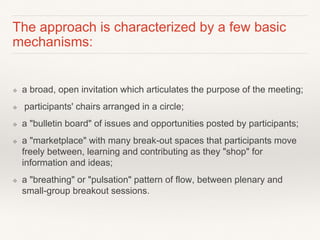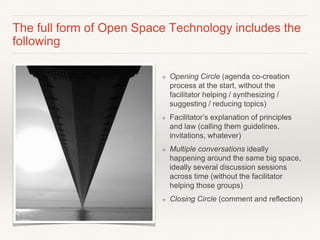Open space tech
- 1. RANDY T. NOBLEZA, Ph.D. Open Space Technology April 18, 2017 EDM 202: social research School of Education
- 2. OST outline â definitions â mechanisms â conditions â principles â suggestions
- 3. Pannwitz Open Space is the only process that focuses on expanding time and space for the force of self- organisation to do its thing. Although one can't predict specific outcomes, it's always highly productive for whatever issue people want to attend to. Some of the inspiring side effects that are
- 4. The approach is characterized by a few basic mechanisms: â a broad, open invitation which articulates the purpose of the meeting; â participants' chairs arranged in a circle; â a "bulletin board" of issues and opportunities posted by participants; â a "marketplace" with many break-out spaces that participants move freely between, learning and contributing as they "shop" for information and ideas; â a "breathing" or "pulsation" pattern of flow, between plenary and small-group breakout sessions.
- 6. Harrison Owen explains that this approach works best when these conditions are present,namely high levels of â complexity â diversity â conflict, real or potential â urgency
- 7. The full form of Open Space Technology includes the following â Opening Circle (agenda co-creation process at the start, without the facilitator helping / synthesizing / suggesting / reducing topics) â Facilitatorâs explanation of principles and law (calling them guidelines, invitations, whatever) â Multiple conversations ideally happening around the same big space, ideally several discussion sessions across time (without the facilitator helping those groups) â Closing Circle (comment and reflection)
- 8. â OST principles âWhoever comes is the right people âĶ. Whenever it starts is the right time âĶ Wherever it is, is the right place âĶ Whatever happens is the only thing that could have, be prepared to be surprised! âĶ When it's over, it's over (within this session) ...â
- 9. Law of two feet If at any time during our time together you find yourself in any situation where you are neither learning nor contributing, use your two feet, go someplace else.
- 11. For running a productive session, consider the following â Scope. A topic that's too broad may not be tractable. â Let people come. Hold the session in a room that's easy to find, and try to avoid holding sessions at the same time if they'll appeal to the same set of attendees. â Let participants contribute. â Let participants' contributions count. â Grow connections. At the end of a session, nurture the opportunity for ongoing collaboration by making time for and encouraging synergistic participants to connect with each other.











